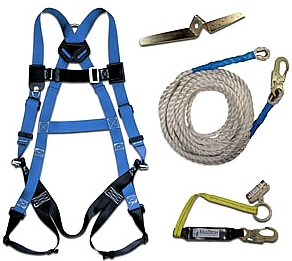Fall Protection Plan
Appalachian State University Facilities Operations is dedicated to the protection of its employees from on-the-job injuries. All employees of Appalachian State University have the responsibility to work safely on the job. The purpose of this plan is:
- To supplement our standard safety policy by providing safety standards specifically designed to cover fall protection on all jobs and;
- to ensure that each employee is trained and made aware of the safety provisions which are to be implemented by this plan prior to the start of construction or maintenance work.
This Fall Protection Plan addresses the use of conventional and other fall protection safeguards in a number of areas, as well as identifying specific activities that require various types of fall protection. Read the Fall Protection Plan (University Policy).

Safety Practices
Purpose
This section is provided as guidelines for University managers, supervisors, and other employees who are involved with worksite operations 4 feet or more above ground level.
Goals
Falls are preventable through use of appropriate employee training, use of appropriate fall protection devices, and proper supervision to prevent the likelihood of employee falls when working at elevated worksites as outlined in the App State Fall Protection Program.
Responsibility
Supervisors and managers are responsible for training and insuring the use of safe fall protection work practices by employees working 4 feet or more above ground level and, in turn complying with North Carolina Department of Labor Occupational Safety and Health Division (NCOSHA) Fall Protection Standards.
Fall Protection Program Strategies
- Increase employee awareness and recognition of potential fall hazards at various worksites (e.g. exposed elevated worksites with unprotected perimeters, elevated areas without guardrails or other barriers).
- Implement appropriate measures to eliminate or control potential fall hazards
- (e.g. effective planning and use of engineering controls, such as guardrails, scaffolds and platform barriers) to provide protection from falls and establish employee working levels at safe, desired heights.
- As a last option, Implement appropriate employee training to properly select and use fall protection equipment to avoid the likelihood of falls from elevated worksites.
Employee Fall Protection Safety Practices
- Personal fall arrest systems are designed to stop a person in a fall.
- Equipment selected will depend on specific job tasks and working environment.
- Basic fall arrest systems consist of an anchorage point, connectors, a full body harness, and a lanyard. Additional features include a deceleration device or a lifeline.
- Fall protection equipment must be inspected by a "competent", trained individual prior to each use. As noted in the Fall Protection Standards, a "competent" person is defined as a person who is capable of identifying hazardous or dangerous conditions in the personal fall arrest system or any component thereof, as well as in their application and use with related equipment.
- Defective equipment must be immediately removed from service and tagged or marked as unusable.
- Fall protection equipment can be washed in warm water, using a mild detergent, rinsed thoroughly, and allowed to dry at room temperature prior to re-use.
Employee Fall Arrest System Equipment Safety Features
- Full Body Harness
- Consists of a set of straps worn around the shoulders, thighs, buttocks and hips.
- Includes an attachment point (Ring) located at the back of the harness for joining to the connecting device.
- Full body harness is the only acceptable body holding device for use in a personal fall arrest system. Body belts and other devices may only be used as positioning devices; these do not prevent the person from slipping out of the belt during a fall.
- Full body harness lessens the jolt to the body by spreading most of the impact forces over the buttocks, thighs, chest, and shoulders.
- Connector
- Most common type of connecting device to a body harness is a lanyard; lanyards join the full body harness to a secure anchorage point.
- Type of connecting device used depends on the potential fall distance, work being performed, and the work environment.
- Additional connecting devices include a shock-absorbing lanyard, self-retracting lifeline, rope grabs, and fall limiters.
- Lanyard
- Short, flexible lines (device) made of rope, high-tensile webbing or steel cable.
- Maximum length must not permit a fall greater than 6 feet.
- Maximum length must not allow the employee to come in contact with lower level hazards.
- Lanyards are attached to an anchorage point by a means that will not reduce its strength, using a locking snap-hook.
- Lanyards must have a minimum breaking strength of 5,000 pounds.
- As a reminder, never tie a knot anywhere in a lanyard; it could reduce its strength by more than 80 percent or more!
- Anchorage
- A secure point of attachment for a personal fall arrest system.
- Must be independent from the means supporting or suspending an employee.
- Must be capable of supporting at least 5,000 pounds per attached employee.
- Must be reachable for attachment without exposure to nearby hazards.
- Must be located (positioned) to prevent the worker from contacting a lower level hazard in the event of a fall.
- Anchorage height must allow the fall arrest system to reduce free fall to the shortest possible distance, not to exceed 6 feet.
- Anchorage height must not allow the employee to contact any lower level hazard during a fall.
Have Questions?
If you have questions or need additional information concerning fall protection, please refer to the App State Fall Protection Plan or contact the Environmental Health Safety & Emergency Managment Office at Extension 4008.